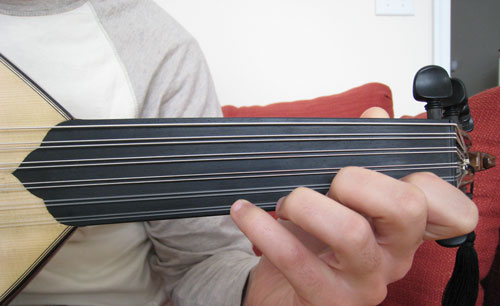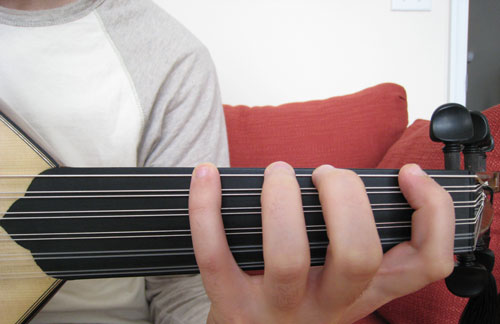

|
| Clean, accurate notes. This is what you need to be able to play well. It doesn't matter what you're playing or how fast you're playing, you need to be able to play cleanly and accurately. The slurs and all the other ornamentations will come easily as you progress and listen to the masters. |
| When we are on the first few courses, our fingers wrap around on a slight angle, as shown
below:
As we move across the fingerboard, our fingers become more perpendicular to the neck:
|
|
As you practice the
major
and
minor
scales, always
make sure you are not rushing. Play cleanly and see that each note is
played with equal strength and tone quality, regardless of the direction
of your
picking.
The exercises below are just simple ways of getting used to the
instrument. Going up and down individual strings. I hope they are
helpful for you as they were for me.
Practice these fingering exercises on each string many times so that your left hand can get used to these intervals. (They are written here as you would play them on the first (D) string. Remember that as you do these your right hand picking should be alternating: down-up-down-up... Ex. #1 is for practicing a major fifth. Ex. #2 is for practicing a minor fifth. Ex. #3 is for practicing a major octave. Ex. #4 is for practicing a minor octave. Using Western scales in the beginning is just fine for getting to know your instrument. When you are absolutely comfortable with these, then it is much easier to move on to Ottoman or other Middle Eastern modes, where the intervals are much more varied. |
|
One more exercise: The major 'bounce.' Do this on each string to help
teach you to cleanly and accurately hit your notes. Also use it with the
minor scale. This is a very useful exercise because we don't always play in
a 'straight line,' often we need to jump to other notes. This will get you
used to finding notes without having a 'lead-in' to them.
|
Copyright © Mavrothi T. Kontanis. All rights reserved 2008